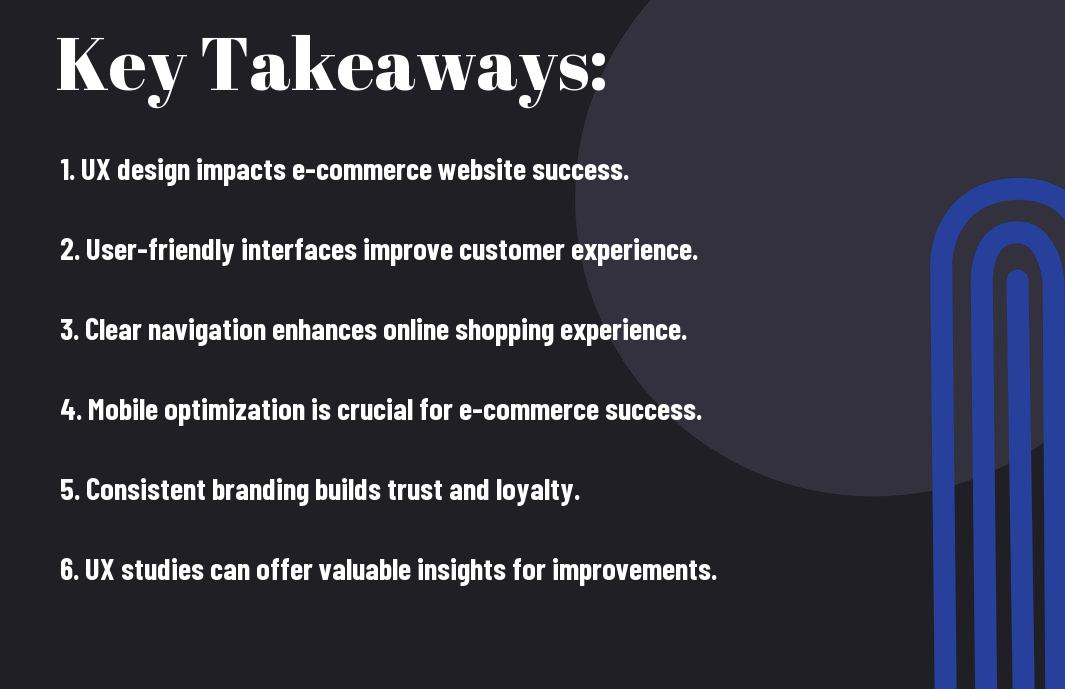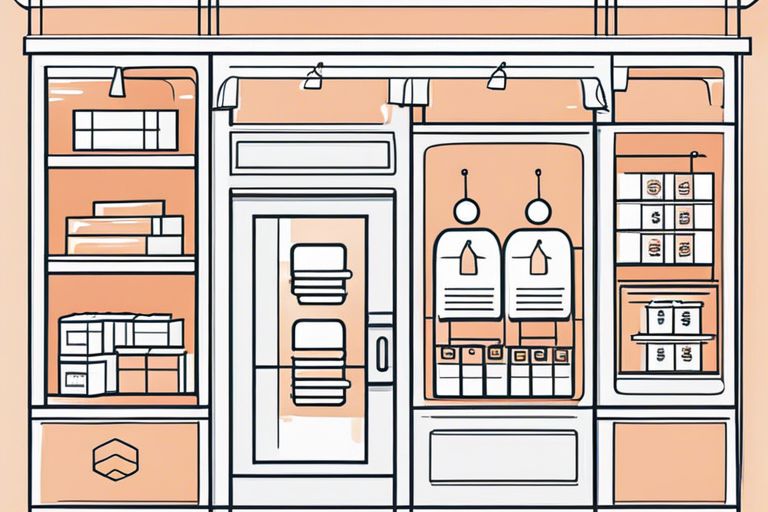Just imagine navigating through an e-commerce website that is cluttered, confusing, and difficult to use. Frustrating, right? That’s where UX design comes in. By focusing on creating a seamless and enjoyable experience for you as a user, UX design plays a crucial role in the success of e-commerce websites. In this article, we’ll investigate into why UX design is so important in the world of online shopping and how it can ultimately impact your browsing and buying experience.
Key Takeaways:
- User Experience (UX) design is crucial in e-commerce websites: The design elements directly impact a customer’s online shopping experience.
- UX design affects conversion rates: A well-designed website improves user engagement and boosts sales.
- Mobile responsiveness is key: With the increasing number of mobile shoppers, ensuring a responsive design is vital for a seamless user experience.
The Rise of E-commerce
The Shift to Online Shopping
While traditional brick-and-mortar stores have been a staple for shopping for decades, the landscape of retail has drastically changed over the past few years. **The convenience and accessibility** of online shopping have transformed the way people buy products. You no longer have to rush through traffic or stand in long lines; you can simply browse, select, and purchase items from the comfort of your own home.
The Importance of Creating a Memorable Online Experience
Shopping online goes beyond just acquiring goods – it’s about the entire experience. **When you visit an e-commerce website, you want it to be easy to navigate, visually appealing, and trustworthy**. An online store that provides a seamless and enjoyable shopping journey is more likely to capture and retain your attention. This is where **the significance of UX design** comes into play.
Plus, **when an e-commerce site is well-designed, you’re more likely to spend time exploring the products, adding items to your cart, and completing the purchase**. **A positive user experience leads to customer satisfaction and builds trust, encouraging repeat business**.


Defining UX Design
It The Role of UX Design in E-commerce Development plays a crucial role in the success of e-commerce websites. To understand its importance, let’s explore into the definition of UX design and its key principles.
What is User Experience Design?
User Experience (UX) Design focuses on enhancing user satisfaction by improving the usability, accessibility, and pleasure provided in the interaction between the user and a product. In the context of e-commerce websites, it involves creating a seamless and enjoyable shopping experience for visitors. This includes user-friendly navigation, clear call-to-action buttons, intuitive search functionality, and overall visual appeal. Effective UX design can significantly impact your business’s online success, influencing conversion rates, customer loyalty, and overall brand perception.
Key Principles of UX Design
For a successful UX design in your e-commerce website, several key principles need to be considered. These include intuitive design, clear communication, feedback incorporation, and consistency in elements such as layout, color scheme, and typography. By adhering to these principles, you can create a website that not only looks visually appealing but also functions seamlessly, providing visitors with a satisfying shopping experience.
Experience It is crucial to continuously analyze user behavior and feedback to iterate and improve the website’s design. By understanding how users interact with your site and making adjustments based on their preferences, you can enhance the overall user experience and drive better results for your e-commerce business.
The Impact of UX Design on E-commerce
Enhancing Customer Satisfaction
To enhance customer satisfaction on your e-commerce website, the user experience design (UX) is key. It involves creating a seamless journey for your customers, making it easy for them to navigate through your site, find what they’re looking for, and ultimately make a purchase. A well-thought-out UX design ensures that your customers have a positive experience with your brand, which can lead to repeat business and positive word-of-mouth referrals.
Increasing Conversion Rates
With effective UX design, you can increase conversion rates on your e-commerce website. By optimizing the user flow, streamlining the checkout process, and reducing friction points, you can guide visitors towards making a purchase. Improving the overall user experience can result in higher conversion rates and ultimately more revenue for your business.
This strategic approach to UX design ensures that your website is intuitive and user-friendly, making it easier for customers to complete transactions. By removing obstacles and distractions along the customer journey, you can significantly impact your conversion rates.
Building Brand Loyalty
On your e-commerce website, building brand loyalty is crucial for long-term success. A thoughtfully designed user experience can foster trust and loyalty with your customers. By consistently delivering exceptional user experiences, you can establish a strong emotional connection with your audience and differentiate your brand from competitors.
Another way UX design contributes to building brand loyalty is by personalizing the shopping experience. By understanding your customers’ preferences and behavior, you can tailor their interactions with your website, creating a personalized and engaging experience that keeps them coming back for more.
Based on the article, improving customer satisfaction, increasing conversion rates, and building brand loyalty are the core benefits of incorporating good UX design principles into your e-commerce website.
Common UX Design Mistakes in E-commerce
Poor Navigation and Information Architecture
After browsing through numerous e-commerce websites, you might have come across ones that left you feeling frustrated due to their poor navigation and confusing information architecture. **Improving navigation** is a crucial aspect of **enhancing user experience** on your website. An unclear menu structure or hidden search bar can lead to **user abandonment** and lost sales. It’s necessary to make it easy for your customers to find what they’re looking for with **intuitive navigation**.
Insufficient Mobile Optimization
Information architecture and navigation are often overlooked when it comes to mobile optimization on e-commerce websites. **E-commerce sites** must be **mobile-responsive** to cater to the rising number of users shopping on their smartphones and tablets. When your website is not **optimized for mobile devices**, you are likely to lose potential customers who encounter **cluttered layouts** or difficulty navigating through the site on their mobile phones.
E-commerce businesses need to prioritize mobile optimization to ensure a seamless shopping experience for their customers across all devices. **Creating a responsive design** that adapts to various screen sizes will **improve user engagement** and **boost conversions**.
Overwhelming Visual Design
Common **UX design** mistake seen in e-commerce websites is overwhelming visual design. **Incorporating too many** **elements**, **colors**, or **pop-ups** on your site can distract users from the **main purpose** of their visit, which is to **shop**. **Simplifying** your layout and **focusing on** **necessary elements** will **improve** the **user experience** and **encourage** **conversion**.
Regarding e-commerce websites, less is often more. Keep your design **clean**, **organized**, and **relevant** to **guide users** effectively through the **purchase journey**.
Effective UX Design Strategies for E-commerce
Personalization and Customization
Not only does a great user experience involve a visually appealing website, but it also requires personalization and customization to cater to your specific needs. One important strategy is to offer personalized product recommendations based on your browsing history and previous purchases. This not only enhances your shopping experience but also increases the likelihood of making a purchase.
Streamlined Checkout Processes
Processes
Notwithstanding a seamless browsing experience, the checkout process is where many e-commerce sites lose you. Long and complicated forms can be a major point of frustration and cause you to abandon your purchase. Implementing a streamlined checkout process with minimal steps and clear instructions can significantly improve your conversion rates.
The checkout process should ideally include multiple payment options, guest checkout for convenience, and the ability to save your information for future purchases. By simplifying this crucial step, e-commerce websites can reduce cart abandonment rates and improve your overall shopping experience.
High-Quality Product Visualization
The
Checkout
With
The Role of UX Design in Competitive Advantage
Differentiating Your Brand Through UX
To differentiate your brand in the competitive landscape of e-commerce, **you** must leverage UX design effectively. **Your** website’s user experience can set **your** brand apart by creating unique and memorable interactions for **your** customers. By focusing on intuitive navigation, visually appealing design, and seamless functionality, **you** can leave a lasting impression on **your** visitors.
Creating a Unique Value Proposition
To establish a strong foothold in the market, **you** need to craft a unique value proposition through **your** UX design. **One** way to achieve this is by understanding **your** target audience’s needs and designing **your** website to fulfill them in the most efficient and enjoyable way possible. By emphasizing **your** brand’s strengths and offering a distinct value to **your** customers, **you** can create a competitive edge that is hard to replicate.
The key to creating a unique value proposition lies in **your** ability to align **your** business goals with **your** customers’ expectations. By conducting thorough research and incorporating feedback into **your** UX design strategy, **you** can tailor **your** offerings to meet the specific needs of **your** target audience, ultimately leading to increased customer loyalty and trust.
Staying Ahead of the Competition
The **advantage** of prioritizing UX design in **your** e-commerce website is that it helps **you** stay ahead of the competition. By continuously innovating and refining **your** user experience, **you** can adapt to changing market trends and consumer preferences more effectively. This proactive approach not only attracts new customers but also retains existing ones, giving **you** a significant edge over competitors.
**Value** in e-commerce is not just about the products or services **you** offer but also about the overall experience **you** provide to **your** customers. By investing in UX design to enhance **your** website’s usability, accessibility, and engagement, **you** can create a compelling brand identity that resonates with **your** target audience, ultimately leading to long-term success in the competitive e-commerce landscape.
Conclusion
Conclusively, understanding the importance of UX design in e-commerce websites is crucial for creating a positive experience for your customers. By focusing on usability, accessibility, and overall user satisfaction, you can enhance your website’s performance and increase customer loyalty and conversions. Bear in mind, a well-designed UX can make the difference between a satisfied customer who returns to make more purchases and a frustrated user who never comes back.
Investing time and resources into optimizing your e-commerce website’s UX design is an investment in your business’s success. By prioritizing user experience, you can stand out in a crowded online marketplace, build trust with your customers, and ultimately drive more sales. So, take the time to analyze and improve your website’s UX design, and watch how it positively impacts your e-commerce business in the long run.